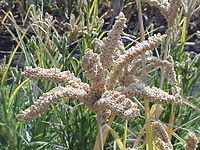
Photo from wikipedia
Abstract Identification and deployment of high-yielding and stress-tolerant maize hybrids adapted to stress-prone agro-ecologies is important for improving the food security and livelihoods of smallholder farmers in eastern Africa. The… Click to show full abstract
Abstract Identification and deployment of high-yielding and stress-tolerant maize hybrids adapted to stress-prone agro-ecologies is important for improving the food security and livelihoods of smallholder farmers in eastern Africa. The objectives of this study were to (i) assess the performance of maize hybrids under well-watered and drought stress conditions; (ii) evaluate grain yield stability of 65 intermediate-maturing and 55 early-maturing hybrids in 24 well-watered locations and seven drought stress locations; and (iii) identify representative and/or discriminative testing locations for increasing genetic gains for the target traits. There were significant differences for grain yield among early- and intermediate-maturing hybrids tested under well-watered and drought stress environments. Among the early-maturing hybrids, the top 10 hybrids produced 46.8%–73.9% and 31.2%–42.1% higher mean grain yields than the best commercial check under drought and well-watered conditions, respectively. Among the intermediate-maturing hybrids, the top 10 hybrids produced 25.2%–47.7% and 8.5%–13.5% higher grain yield than commercial checks under drought stress and well-watered conditions, respectively, suggesting improvement in the levels of drought tolerance in both early- and intermediate-maturing hybrids. GGE biplot analysis and a bi-segmented regression linear method identified specific early-maturing and intermediate-maturing hybrids that performed well under both well-watered and drought stress conditions. These hybrids could be recommended for commercial production in eastern Africa. Kakamega in Kenya was found to be the most representative and highly discriminating site among well-watered testing locations, while Kabuku in Tanzania was the least representative of test locations. For testing under drought stress conditions, Kiboko in Kenya was identified as the most representative location. This information could be useful for allocating resources and streamlining CIMMYT maize hybrid testing in eastern Africa.
Journal Title: Crop Journal
Year Published: 2020
Link to full text (if available)
Share on Social Media: Sign Up to like & get
recommendations!